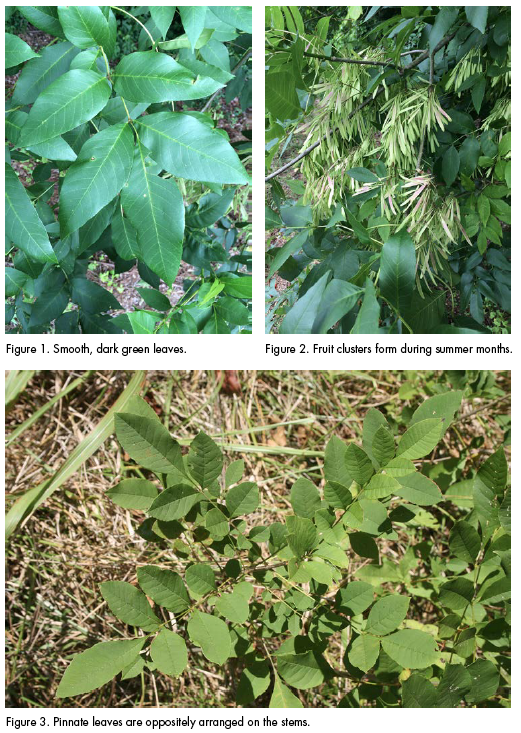Controlling Hardy Hardwoods in Pasture Systems
Livestock and forage producers often have a hard time keeping small, herbaceous weeds controlled, in order to produce more high-quality forage and improve animal gains. Perennial, woody vegetation complicates control decisions because of its hardiness and vigorous growth.
Green ash and post oak are two species that create problems in pastures across the Southeast. Fortunately, there are similar herbicide control options for both when they become a problem in forage pastures.
Green Ash
Green ash (Fraxinus pennsylvanica Marsh.) is a medium-sized deciduous tree naturally found along streams, woodlands, alluvial floodplains, where frequent flooding occurs, or on other soils with high moisture-holding capacity. This species is adapted to Mississippi, and, in more urban-aesthetic landscapes, it is considered an attractive tree that provides shade and curb appeal. However, in the fine-textured clay soils of the Black Belt Prairie region, this vigorous species can quickly become a nuisance in pastures.
At maturity, green ash can reach heights of 50–100 feet. Leaves are lush green, pinnate, opposite, and slightly gray on the underside. The ovate to elliptical leaves have smooth or slightly serrated edges (Figures 1 and 3). The bark is smooth, pale gray, and tight, with furrows forming a diamond-shaped pattern as the tree matures. Flowers are purplish-red lobes that form in compound clusters and appear before the leaves emerge in the spring. The fruits form in large clusters and are paddle-shaped, with wings enclosing half the seed (Figure 2).
Green ash seed are primarily spread by wind, but the seed may be carried by animals or surface water. Seed dispersed in the fall will germinate the following spring. Therefore, this species may quickly colonize nearby pastures.

Post Oak
Post oak (Quercus stellata Wangenh.) is widely known as a tough, resilient tree that can survive harsh conditions. Often found in poor, upland, sandy to clay soils, the common name originates from its use as fence posts. This species is distributed throughout Mississippi, with the exception of the alluvial Delta floodplains. While post oak is not a preferred timber species for lumber, it has value for providing cover, cavities, and acorns for wildlife.
Post oak most often grows with a single trunk and can reach 80 feet at maturity. As a young seedling, post oak can be identified by its simple, alternate, deeply lobed leaves. These rounded leaves are often leathery, rough-textured, and dark green (Figures 4 and 5). Undersides of leaves are yellowish to gray-green with star-shaped hairs. As this species matures, it can be identified by its gray, cracked, and scaly bark. Seedlings may inhabit pastures and hay fields as acorns are dispersed by birds, mammals, or hay movement (Figure 6).

Threat and Control Measures
Both of these woody plants can establish quickly without proper management. Ruminants are not prone to consume saplings because tannins in leaves, buds, and acorns of post oak are moderately toxic. Therefore, control is necessary to increase desirable forage species.
Mowing is a common method of management in overgrown areas, because livestock selectively graze desirable, herbaceous vegetation. However, mowing has little effect on the rootstock of either plant, as sprouting will occur from growth points below the soil surface.
Broadcast Foliar Treatments
Selected herbicides are an effective option for controlling both woody species when applied postemergence. Broadcast applications with a boomless nozzle are highly effective when plant populations are dense, like those in Figure 6. In two recent field studies, each lasting at least 13 months, triclopyr was superior to other herbicides at controlling both species (Table 1). Triclopyr provided more than 90 percent control of both species for more than 1 year after treatment, when applied to vegetation under 4 feet tall. Observations for imazapyr and metsulfuron treatments showed varying responses in the same studies. Imazapyr was less effective on green ash (35 percent control) but provided greater than 82 percent post oak control. Metsulfuron was less effective on post oak (5 percent control) but provided 80 percent green ash control. A minimum spray volume of 15 gallons per acre (GPA) is suggested, but spray volume should be increased as plant density and/or height increases, to ensure thorough coverage.
|
Table 1. Suggested postemergence, broadcast herbicide treatments and rates effective on green ash and post oak. At least 15 GPA suggested spray volume. |
||
|
Herbicide |
Trade Name |
Rate (amount product/A) |
|
Green Ash |
||
|
triclopyr |
Remedy Ultra, Trycera, Triclopyr, etc. |
48 fl oz |
|
metsulfuron |
Cimarron, Patriot, MSM, etc. |
2 oz |
|
Post Oak |
||
|
triclopyr |
Remedy Ultra, Trycera, Triclopyr, etc. |
24 fl oz |
|
imazapyr |
Arsenal, Polaris, Imazapyr, etc. |
48 fl oz |
|
All treatments include 0.25% v/v non-ionic surfactant. |
||
Basal Bark Treatments
Individual plant treatments may be more appropriate in areas where the population of woody species is low. Basal bark applications are made to the basal parts of brush less than 6 inches in diameter, to a height of 12–24 inches from the ground, in a manner that thoroughly wets the entire lower stem. When using triclopyr to control these plants with a large sprayer, mix 25–30 gallons (25–30 percent solution) of Remedy Ultra (or an equivalent 4 lb a.e./gallon ester formulation of triclopyr) with 10 gallons (10 percent) penetrant, such as Cidekick, in enough oil or diesel fuel to make 100 gallons of spray mixture. For small infestations, mix 32–38 fluid ounces Remedy Ultra (or an equivalent 4 lb a.e./gallon ester formulation of triclopyr) with 13 fluid ounces penetrant and enough diesel fuel or oil to make 1 gallon spray mix; use a backpack or knapsack sprayer equipped with a solid cone, flat-fan nozzle, or straight stream spray.
Cut-Stump Treatments
Cut-stump applications are useful in areas where the density of the brush is low, where damage to forage species must be avoided, where plants are too tall for foliar treatment, and along fence rows. Woody trunks should be cut as close to the ground as possible. To control resprouting, spray or paint herbicide to thoroughly treat the root collar area, the sides of the stump, and the outer portion of the cut surface, including the cambium. Triclopyr is effective when mixed at 26–32 fluid ounces of Remedy Ultra (or an equivalent 4 lb a.e./gallon ester formulation of triclopyr) in enough oil or diesel fuel to make 1 gallon of spray mixture.
Arsenal (or other 2 lb a.e./gallon imazapyr formulation) is effective as either a concentrate or a dilute solution to treat cut stumps or to treat cuts on the stem. Dilute solutions include 8–12 fluid ounces Arsenal with 1 gallon of water. Concentrate solutions include 2 parts Arsenal (or other 2 lb a.e./gallon imazapyr formulation) to 1 part water, such as 2 quarts Arsenal (or other 2 lb a.e./gallon imazapyr formulation) mixed with 1 quart water. Apply anytime, including in winter months, except when snow or water prevent spraying along the ground line.
Restrictions
Triclopyr may be used for the spot treatment of individual plants at a maximum use rate of 8 lb a.e./acre (2 gallons or less Remedy Ultra, or an equivalent 4 lb a.e./gallon ester formulation of triclopyr, per acre). Basal bark or cut-stump treatments are made directly to ungrazed parts of plants and, therefore, are not restricted by the grazing maximum rate of 2 lb a.e./acre (1 gallon or less Remedy Ultra, or an equivalent 4 lb a.e./gallon ester formulation of triclopyr, per acre). Except for lactating dairy animals, there are no grazing restrictions following triclopyr applications. Lactating dairy animals should not graze treated areas until the next growing season. Do not harvest hay for 14 days after application. Livestock should be removed from grazing treated grass at least 3 days before animal harvest.
Imazapyr may be applied as a spot treatment at 0.031–0.75 lb a.e./acre (2–48 fluid ounces Arsenal, or other 2 lb a.e./gallon imazapyr formulation, per acre). There are no grazing restrictions following imazapyr; however, treated grass should not be cut for hay for at least 7 days after application.
Spot treatments with both triclopyr and imazapyr should not exceed 10 percent of the area to be grazed or cut for hay.
There are no grazing or haying restrictions with the use of metsulfuron products.
Under normal weather conditions, do not mow for at least 4–6 weeks after application for the best control. Producers should note that imazapyr will severely damage all desirable forage species, and it should not be applied to desirable trees. Metsulfuron will suppress tall fescue and bahiagrass. Temporary suppression of bermudagrass growth may occur with the use of triclopyr under ideal growing conditions.
References
Dickerson, J. (2002). Plant fact sheet for green ash (Fraxinus pennsylvanica). USDA–NRCS New York State Office, Syracuse, New York.
Hodges, J. D., Evans, D. L., & Garnett, L. W. (2012). Mississippi Trees, Second Edition. Mississippi Forestry Commission. p. 369.
Stransky, J. J. (1990). Quercus stellata Wangenh.—post oak. Silvics of North America, 2, pp.738–743.
The information given here is for educational purposes only. References to commercial products, trade names, or suppliers are made with the understanding that no endorsement is implied and that no discrimination against other products or suppliers is intended.
Publication 3052 (POD-03-17)
By David P. Russell, Extension Associate II, Dr. John D. Byrd, Extension/Research Professor, and Maria Leticia Zaccaro, Graduate Research Assistant, Plant and Soil Sciences.
The Mississippi State University Extension Service is working to ensure all web content is accessible to all users. If you need assistance accessing any of our content, please email the webteam or call 662-325-2262.


